+ Open data
Open data
- Basic information
Basic information
| Entry | Database: PDB / ID: 2hd5 | ||||||
|---|---|---|---|---|---|---|---|
| Title | USP2 in complex with ubiquitin | ||||||
 Components Components |
| ||||||
 Keywords Keywords |  HYDROLASE / deubiquitinating protease / HYDROLASE / deubiquitinating protease /  cysteine protease / substrate enzyme complex cysteine protease / substrate enzyme complex | ||||||
| Function / homology |  Function and homology information Function and homology informationOxidative Stress Induced Senescence / Oncogene Induced Senescence / : / Stabilization of p53 / : / IRAK1 recruits IKK complex / TRAF6 mediated IRF7 activation in TLR7/8 or 9 signaling / IRAK1 recruits IKK complex upon TLR7/8 or 9 stimulation / : / TAK1-dependent IKK and NF-kappa-B activation ...Oxidative Stress Induced Senescence / Oncogene Induced Senescence / : / Stabilization of p53 / : / IRAK1 recruits IKK complex / TRAF6 mediated IRF7 activation in TLR7/8 or 9 signaling / IRAK1 recruits IKK complex upon TLR7/8 or 9 stimulation / : / TAK1-dependent IKK and NF-kappa-B activation / Major pathway of rRNA processing in the nucleolus and cytosol / GTP hydrolysis and joining of the 60S ribosomal subunit / Translesion synthesis by REV1 / Recognition of DNA damage by PCNA-containing replication complex / Translesion Synthesis by POLH / Downregulation of ERBB4 signaling / Spry regulation of FGF signaling / Downregulation of ERBB2:ERBB3 signaling / NOD1/2 Signaling Pathway / APC/C:Cdc20 mediated degradation of Cyclin B / SCF-beta-TrCP mediated degradation of Emi1 / APC-Cdc20 mediated degradation of Nek2A / EGFR downregulation / TCF dependent signaling in response to WNT / NRIF signals cell death from the nucleus / p75NTR recruits signalling complexes / NF-kB is activated and signals survival / Activated NOTCH1 Transmits Signal to the Nucleus / Downregulation of TGF-beta receptor signaling / TGF-beta receptor signaling in EMT (epithelial to mesenchymal transition) / Downregulation of SMAD2/3:SMAD4 transcriptional activity / SMAD2/SMAD3:SMAD4 heterotrimer regulates transcription / Senescence-Associated Secretory Phenotype (SASP) / Regulation of innate immune responses to cytosolic DNA / activated TAK1 mediates p38 MAPK activation / JNK (c-Jun kinases) phosphorylation and activation mediated by activated human TAK1 / Regulation of FZD by ubiquitination / PINK1-PRKN Mediated Mitophagy / N-glycan trimming in the ER and Calnexin/Calreticulin cycle / Regulation of TNFR1 signaling / TNFR1-induced NF-kappa-B signaling pathway / Translesion synthesis by POLK / Translesion synthesis by POLI / Regulation of necroptotic cell death / MAP3K8 (TPL2)-dependent MAPK1/3 activation / HDR through Homologous Recombination (HRR) / Josephin domain DUBs / Recruitment and ATM-mediated phosphorylation of repair and signaling proteins at DNA double strand breaks / DNA Damage Recognition in GG-NER / Formation of Incision Complex in GG-NER / Gap-filling DNA repair synthesis and ligation in GG-NER / Dual Incision in GG-NER / Fanconi Anemia Pathway / Regulation of TP53 Activity through Phosphorylation / Regulation of TP53 Degradation / Regulation of TP53 Activity through Methylation / Negative regulation of MET activity / Cyclin D associated events in G1 / PTK6 Regulates RTKs and Their Effectors AKT1 and DOK1 / Downregulation of ERBB2 signaling / E3 ubiquitin ligases ubiquitinate target proteins / Regulation of PTEN localization / ER Quality Control Compartment (ERQC) / Regulation of expression of SLITs and ROBOs / Interferon alpha/beta signaling / Endosomal Sorting Complex Required For Transport (ESCRT) / Activation of IRF3, IRF7 mediated by TBK1, IKKε (IKBKE) / IKK complex recruitment mediated by RIP1 / IRAK2 mediated activation of TAK1 complex / TRAF6-mediated induction of TAK1 complex within TLR4 complex / Alpha-protein kinase 1 signaling pathway / RAS processing / Pexophagy / Inactivation of CSF3 (G-CSF) signaling / Negative regulation of FLT3 /  Regulation of BACH1 activity / IRAK2 mediated activation of TAK1 complex upon TLR7/8 or 9 stimulation / Regulation of NF-kappa B signaling / Termination of translesion DNA synthesis / Ovarian tumor domain proteases / Negative regulators of DDX58/IFIH1 signaling / Negative regulation of FGFR1 signaling / Negative regulation of FGFR2 signaling / Negative regulation of FGFR3 signaling / Negative regulation of FGFR4 signaling / Negative regulation of MAPK pathway / Synthesis of active ubiquitin: roles of E1 and E2 enzymes / Iron uptake and transport / Deactivation of the beta-catenin transactivating complex / Metalloprotease DUBs / Formation of TC-NER Pre-Incision Complex / Dual incision in TC-NER / Gap-filling DNA repair synthesis and ligation in TC-NER / Activation of NF-kappaB in B cells / L13a-mediated translational silencing of Ceruloplasmin expression / Autodegradation of Cdh1 by Cdh1:APC/C / APC/C:Cdc20 mediated degradation of Securin / APC/C:Cdh1 mediated degradation of Cdc20 and other APC/C:Cdh1 targeted proteins in late mitosis/early G1 / Cdc20:Phospho-APC/C mediated degradation of Cyclin A / SRP-dependent cotranslational protein targeting to membrane Regulation of BACH1 activity / IRAK2 mediated activation of TAK1 complex upon TLR7/8 or 9 stimulation / Regulation of NF-kappa B signaling / Termination of translesion DNA synthesis / Ovarian tumor domain proteases / Negative regulators of DDX58/IFIH1 signaling / Negative regulation of FGFR1 signaling / Negative regulation of FGFR2 signaling / Negative regulation of FGFR3 signaling / Negative regulation of FGFR4 signaling / Negative regulation of MAPK pathway / Synthesis of active ubiquitin: roles of E1 and E2 enzymes / Iron uptake and transport / Deactivation of the beta-catenin transactivating complex / Metalloprotease DUBs / Formation of TC-NER Pre-Incision Complex / Dual incision in TC-NER / Gap-filling DNA repair synthesis and ligation in TC-NER / Activation of NF-kappaB in B cells / L13a-mediated translational silencing of Ceruloplasmin expression / Autodegradation of Cdh1 by Cdh1:APC/C / APC/C:Cdc20 mediated degradation of Securin / APC/C:Cdh1 mediated degradation of Cdc20 and other APC/C:Cdh1 targeted proteins in late mitosis/early G1 / Cdc20:Phospho-APC/C mediated degradation of Cyclin A / SRP-dependent cotranslational protein targeting to membraneSimilarity search - Function | ||||||
| Biological species |   Homo sapiens (human) Homo sapiens (human)  Bos taurus (cattle) Bos taurus (cattle) | ||||||
| Method |  X-RAY DIFFRACTION / X-RAY DIFFRACTION /  MOLECULAR REPLACEMENT / Resolution: 1.85 Å MOLECULAR REPLACEMENT / Resolution: 1.85 Å | ||||||
 Authors Authors | Renatus, M. / Kroemer, M. | ||||||
 Citation Citation |  Journal: Structure / Year: 2006 Journal: Structure / Year: 2006Title: Structural Basis of Ubiquitin Recognition by the Deubiquitinating Protease USP2. Authors: Renatus, M. / Parrado, S.G. / D'Arcy, A. / Eidhoff, U. / Gerhartz, B. / Hassiepen, U. / Pierrat, B. / Riedl, R. / Vinzenz, D. / Worpenberg, S. / Kroemer, M. | ||||||
| History |
|
- Structure visualization
Structure visualization
| Structure viewer | Molecule:  Molmil Molmil Jmol/JSmol Jmol/JSmol |
|---|
- Downloads & links
Downloads & links
- Download
Download
| PDBx/mmCIF format |  2hd5.cif.gz 2hd5.cif.gz | 96.9 KB | Display |  PDBx/mmCIF format PDBx/mmCIF format |
|---|---|---|---|---|
| PDB format |  pdb2hd5.ent.gz pdb2hd5.ent.gz | 71.1 KB | Display |  PDB format PDB format |
| PDBx/mmJSON format |  2hd5.json.gz 2hd5.json.gz | Tree view |  PDBx/mmJSON format PDBx/mmJSON format | |
| Others |  Other downloads Other downloads |
-Validation report
| Arichive directory |  https://data.pdbj.org/pub/pdb/validation_reports/hd/2hd5 https://data.pdbj.org/pub/pdb/validation_reports/hd/2hd5 ftp://data.pdbj.org/pub/pdb/validation_reports/hd/2hd5 ftp://data.pdbj.org/pub/pdb/validation_reports/hd/2hd5 | HTTPS FTP |
|---|
-Related structure data
- Links
Links
- Assembly
Assembly
| Deposited unit | 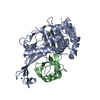
| ||||||||
|---|---|---|---|---|---|---|---|---|---|
| 1 |
| ||||||||
| Unit cell |
| ||||||||
| Components on special symmetry positions |
|
- Components
Components
| #1: Protein | Mass: 41422.891 Da / Num. of mol.: 1 / Fragment: residues 258-605 Source method: isolated from a genetically manipulated source Source: (gene. exp.)   Homo sapiens (human) / Gene: USP2, UBP41 / Plasmid: pET24a / Production host: Homo sapiens (human) / Gene: USP2, UBP41 / Plasmid: pET24a / Production host:   Escherichia coli (E. coli) / Strain (production host): Rosetta (DE3)pLysS / References: UniProt: O75604, EC: 3.1.2.15 Escherichia coli (E. coli) / Strain (production host): Rosetta (DE3)pLysS / References: UniProt: O75604, EC: 3.1.2.15 |
|---|---|
| #2: Protein | Mass: 8576.831 Da / Num. of mol.: 1 / Fragment: residues 1-76 / Source method: isolated from a natural source / Source: (natural)   Bos taurus (cattle) / References: UniProt: Q24K23, UniProt: P0CH28*PLUS Bos taurus (cattle) / References: UniProt: Q24K23, UniProt: P0CH28*PLUS |
| #3: Chemical | ChemComp-ZN / |
| #4: Water | ChemComp-HOH /  Water Water |
-Experimental details
-Experiment
| Experiment | Method:  X-RAY DIFFRACTION / Number of used crystals: 1 X-RAY DIFFRACTION / Number of used crystals: 1 |
|---|
- Sample preparation
Sample preparation
| Crystal | Density Matthews: 1.74514 Å3/Da / Density % sol: 29.518539 % Description: CRYSTALS WERE DEHYDRATED PRIOR TO THE DATA COLLECTION. |
|---|---|
Crystal grow | Temperature: 295 K / Method: liquid diffusion / pH: 6.5 Details: 200 mM MgCl2, 25% PEG 3550, 100 mM Bis-Tris, Protein at 11.8 mg/ml, pH 6.5, LIQUID DIFFUSION, temperature 295K |
-Data collection
| Diffraction | Mean temperature: 100 K |
|---|---|
| Diffraction source | Source:  ROTATING ANODE / Wavelength: 1.5418 Å ROTATING ANODE / Wavelength: 1.5418 Å |
| Detector | Type: RIGAKU SATURN 92 / Detector: CCD / Date: Jan 15, 2005 / Details: CONFOCAL MAX-FLUX |
| Radiation | Monochromator: CONFOCAL MAX-FLUX MULTILAYER OPTICS / Protocol: SINGLE WAVELENGTH / Monochromatic (M) / Laue (L): M / Scattering type: x-ray |
| Radiation wavelength | Wavelength : 1.5418 Å / Relative weight: 1 : 1.5418 Å / Relative weight: 1 |
| Reflection | Resolution: 1.85→50.2 Å / Num. obs: 28474 / % possible obs: 95.5 % / Observed criterion σ(F): 0 / Observed criterion σ(I): 0 / Redundancy: 4.1 % / Rsym value: 0.061 / Net I/σ(I): 16.1 |
| Reflection shell | Resolution: 1.85→1.93 Å / Mean I/σ(I) obs: 4 / Rsym value: 0.213 / % possible all: 81.8 |
- Processing
Processing
| Software |
| ||||||||||||||||||||||||||||||||||||
|---|---|---|---|---|---|---|---|---|---|---|---|---|---|---|---|---|---|---|---|---|---|---|---|---|---|---|---|---|---|---|---|---|---|---|---|---|---|
| Refinement | Method to determine structure : :  MOLECULAR REPLACEMENT MOLECULAR REPLACEMENTStarting model: 1OGW and 1NBF, chain C Resolution: 1.85→41.47 Å / Rfactor Rfree error: 0.006 / FOM work R set: 0.869 / Data cutoff high absF: 2622971 / Data cutoff low absF: 0 / Isotropic thermal model: RESTRAINED / Cross valid method: THROUGHOUT / σ(F): 0 / Stereochemistry target values: Engh & Huber
| ||||||||||||||||||||||||||||||||||||
| Solvent computation | Solvent model: FLAT MODEL / Bsol: 45.545 Å2 / ksol: 0.392 e/Å3 | ||||||||||||||||||||||||||||||||||||
| Displacement parameters | Biso mean: 23 Å2
| ||||||||||||||||||||||||||||||||||||
| Refine analyze |
| ||||||||||||||||||||||||||||||||||||
| Refinement step | Cycle: LAST / Resolution: 1.85→41.47 Å
| ||||||||||||||||||||||||||||||||||||
| Refine LS restraints |
| ||||||||||||||||||||||||||||||||||||
| LS refinement shell | Resolution: 1.85→1.97 Å / Rfactor Rfree error: 0.018 / Total num. of bins used: 6
| ||||||||||||||||||||||||||||||||||||
| Xplor file |
|
 Movie
Movie Controller
Controller



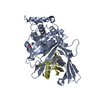


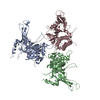

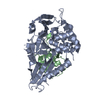

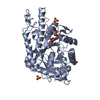
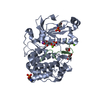
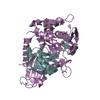
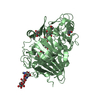

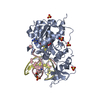
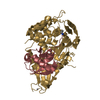
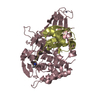
 PDBj
PDBj






